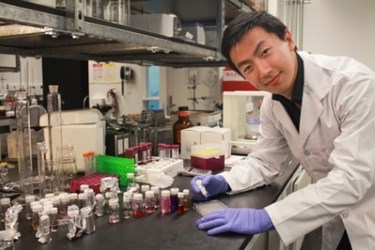Nanoparticles Provide Relief For Dry Eyes
By Chuck Seegert, Ph.D.

Patients suffering from dry eye syndrome may now only have to medicate once a week, instead of three times a day. Drug-infused nanoparticles from researchers at Waterloo University (WU) are behind this increased convenience.
Chronic lack of lubrication is the primary cause of an irritating condition called dry eye syndrome. A lack of tears is at the root of this condition, and it can lead to redness and irritation to the front of the eye, or even more extensive eye damage. This condition is generally a problem for people over 50, and it affects up to 6 percent of the U.S. population, according to a recent press release.
Historically dry eye patients have needed to administer medicated drops up to three times a day. Due to the eye’s ability to clean itself, the drops and the therapeutics in them are washed from the surface. To combat this problem, UW scientists developed a mucoadhesive nanoparticle system, according to a study recently published by the team in Nano Research.
The particles are capable of adhering to membranes like those seen in the eye, because of some unique properties that were designed into their surfaces. The particles themselves are synthesized from a copolymer of poly-L-lactide and Dextran, but their adhesive properties are achieved by chemically bonding phenylboronic acid to their surfaces, according to the study. This adhesion prevents the nanoparticles from washing away for up to a week, during which they can deliver drugs to the eye.
“You can’t tell the difference between these nanoparticle eye drops and water,” said Shengyan (Sandy) Liu, a Ph.D. candidate at Waterloo's Faculty of Engineering who led the team of researchers from the Department of Chemical Engineering and the Centre for Contact Lens Research, in the press release. “There’s no irritation to the eye.”
In addition to providing convenience, the nanoparticle formulation may have other health-related benefits.
“I knew that if we focused on infusing biocompatible nanoparticles with Cyclosporine A, the drug in the eye drops, and make them stick to the eyeball without irritation for longer periods of time, it would also save patients time and reduce the possibility of toxic exposure due to excessive use of eye drops,” Liu said in the press release.
Success of these early experiments has the team hopeful that they will be able to run clinical trials in the near future and commercialize the product within approximately five years, according to the press release.
Nanoparticles are being extensively explored for targeted drug delivery and smart applications where they release their payload at controlled times and locations. Recently, in an article published on Med Device Online, a “nanorocket” was discussed that can propel itself to a location and then release drugs after exposure to a magnetic field.
Image Credit: Shengyan (Sandy) Liu, University of Waterloo
